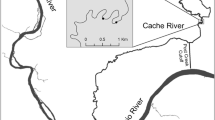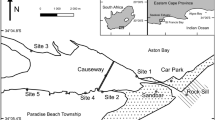Abstract
Loss of wetland habitat has proceeded at an alarmingrate in southern California, and increasingly marshrestoration and creation are being used to mitigatethese losses. As part of an effort to evaluatefunctional equivalence of created systems, theichthyofaunal assemblages in a created and adjacentnatural marsh in Mission Bay, San Diego, Californiawere compared. Fishes trapped in both marshes includedFundulus parvipinnis, Gillichthysmirabilis, Acanthogobius flavimanus, Ctenogobius sagittula, Atherinops affinis, andMugil cephalus. Fundulus parvipinniswasnumerically dominant in both systems, representing onaverage 69% of all fishes trapped in the createdmarsh and 65% of all fishes trapped in the naturalmarsh. Gillichthys mirabiliswas the second-mostabundant species, representing on average 31% of allfishes trapped in the created marsh and 28% of allfishes trapped in the natural marsh. Species richnessand dominance measures were similar between the twosystems, while abundances were higher in the naturalrelative to the created marsh. The size-structure ofF. parvipinnisand G. mirabilisdifferedbetween the created and natural marsh creeks, with thecreated marsh populations being skewed towards largersize classes. These size differences are believed toarise from differences in creek morphology between thecreated and natural systems, and potentially affectboth predators and prey of these species in the marsh.Mark-release-recapture revealed considerable marshfidelity, with as many as 35% of the F.parvipinnistagged in a marsh being recovered one daylater in the same marsh. Stable isotope analyses ofF. parvipinnisrevealed similar δ15Nand δ34S values between marshes; howeverthere was a consistent enrichment in 13C (>3per mil) in tissues of F. parvipinnisfrom thecreated marsh, supporting the high marsh fidelitysuggested by tagging results. This first publisheddocumentation of the Mission Bay marsh resident fishessuggests that the created marsh ichthyofaunalassemblage was distinct in density and size structurefrom the adjacent natural marsh, and provides lessonsfor future restoration efforts.
Similar content being viewed by others
References
Allen, E.A., Fell, P.E., Peck, M.A., Gieg, J.A., Guthke, C.R. and Newkirk, M.D. 1994. Gut contents of common mummichogs, Fundulus heteroclitus L., in a restored impounded marsh and in natural reference marshes. Estuaries 17: 462–471.
Allen, L.G. 1980. Structure and productivity of the littoral fish assemblage of upper Newport Bay, California. Ph.D. Thesis, University of Southern California, Los Angeles. 175 pp.
Allen, L.G. 1982. Seasonal abundance, composition, and productivity of the littoral fish assemblage in Upper Newport Bay, California. Fishery Bulletin 80: 769–790.
Black, G.F. 1980. Status of the Desert Pupfish, Cyprinodon macularius (Baird and Girard), in California. Inland Fisheries Endangered Species Program, Special Publication 80-1. State of California Department of Fish and Game, Sacramento.
Barnston, A.G., Glantz, M.H. and He, Y.X. 1999. Predictive skill of statistical and dynamical climate models in SST forecasts during the 1997-1998 El Niño episode and the 1998 La Niña onset. Bulletin of the American Meteorological Society 80: 217–243.
Desmond, J.S. 1996. Species composition and size structure of fish assemblages in relation to tidal creek size in southern California coastal wetlands. MS Thesis. San Diego State University.
Eschmeyer, W.N. and Herald, E.S. 1983. A field guide to Pacific Coast fishes of North America: from the Gulf of Alaska to Baja, California. The Peterson field guide series. Houghton Mifflin, Boston, xii.
Fitch, J.E. and Lavenberg, R.J. 1975. Tidepool and Nearshore Fishes of California. California Natural History Guides; 38. University of California Press, Berkeley.
Fritz, E.S. 1975. The life history of the California killifish, Fundulus parvipinnis Girard, in Anaheim Bay, California. California Department of Fish and Game, Fish Bulletin 165: 91–106.
Gerking, S.D. 1994. Feeding Ecology of Fish. Academic Press, San Diego.
Halpin, P.M. 1997. Habitat use patterns of the mummichog, Fundulus heteroclitus, in New England. I. Intramarsh variation. Estuaries 20: 618–625.
Hartney, K.B. and Tumyan, L. 1998. Temporal changes in diet and foraging habitat of California killifish (Fundulus parvipinnis) in Marina del Rey, California. Bulletin of the Southern California Academy of Sciences 97: 1–8.
Harvey, H.H. and Jackson, D.A. 1997. Qualitative and quantitative sampling of lake fish communities. Canadian Journal of Fisheries and Aquatic Science 54: 2807–2815.
Havens, K.J., Varnell, L.M. and Bradshaw, J.G. 1995 An assessment of ecological conditions in a constructed tidal marsh and two natural reference coastal marshes in coastal Virginia. Ecological Engineering 4: 117–141.
Horn, M.H. 1980. Diversity and ecological roles of noncommercial fishes in California marine habitats. CalCOFI Reports. XXI: 37–47.
Horn, M.H. and Allen, L.G. 1985. Fish community ecology in southern California bays and estuaries. In: A. Yáñez-Arancibia (ed.), Fish Community Ecology in Estuaries and Coastal Lagoons: Towards an Ecosystem Integration. pp. 654. UNAM Press, Mexico.
Horton, R.E. 1945. Erosional development of streams and their drainage basins; hydrophysical approach to quantitative morphology. Bulletin of the Geological Society of America 56: 275–370.
Juanes, F. 1994. What determines prey size selectivity in piscivorous fishes? In: Strouder, D.J., Fresh, K.L. and Feller, R.J. (eds.), Theory and Application in Fish Feeding Ecology. The University of South Carolina Press, Columbia SC.
Kelso, W.E. 1979. Predation on soft-shell clams, Mya arenaria, by the common mummichog, Fundulus heteroclitus. Estuaries 2: 249–254.
Kersten, M., Britton, R.H., Dugan, P.J. and Hafner, H. 1991. Flock feeding and food intake in little egrets: The effects of prey distribution and behavior. Journal of Animal Ecology 60: 241–252.
Kneib, R.T. 1986. The role of Fundulus heteroclitus in salt marsh trophic dynamics. American Zoologist 26: 259–269.
Kneib, R.T. 1987. Predation risk and use of intertidal habitats by young fishes and shrimp. Ecology 68: 379–386.
Kneib, R.T. 1988. Testing for indirect effects of predation in an intertidal soft-bottom community. Ecology 69: 1795–1805.
Kneib, R.T. 1997. Early life stages of resident nekton in intertidal marshes. Estuaries 20: 214–230.
Kneib, R.T. and Stiven, A.E. 1982. Benthic invertebrate responses to size and density manipulations of the common mummichog, Fundulus heteroclitus, in an intertidal salt marsh. Ecology 63: 1518–1532.
Krebs, C.J. 1989. Ecological Methodology. Harper Collins, New York.
Kwak, T.J. and Zedler, J.B. 1997. Food web analysis of southern California coastal wetlands using multiple stable isotopes. Oecologia (Berlin) 110: 262–277.
Lafferty, K.D. and Morris, A.K. 1996. Altered behavior of parasitized killifish increases susceptibility to predation by final bird hosts. Ecolog 77: 1390–1397.
Lajtha, K. and Michener, R.H. 1994. Stable Isotopes in Ecology and Environmental Science. Blackwell Scientific Publishers, Ltd. Oxford, England.
Landin, M.C., Clairain, E.J.J. and Newling, C.J. 1989. Wetland habitat development and long-term monitoring at Windmill Point, Virginia [USA]. Wetlands 9: 13–26.
LaSalle, M.W., Landin, M.C. and Sims, J.G. 1991. Evaluation of the flora and fauna of a Spartina alterniflora marsh established on dredged material in Winyah Bay, South Carolina. Wetlands 11: 191–208.
Levin, L.A., Talley, T.S., Talley, D.M., Currin, C. and Michener, R. 1999. Trophic interactions in a created and natural salt marsh inferred from stable isotope analyses. 28th Annual Benthic Ecology Meetings, March 1999, Baton Rouge, LA.
Marcus, L. 1989. The Coastal Wetlands of San Diego County. California State Coastal Conservancy, Sacramento.
McCray, A.T, Talley, T.S. and Robles-Bustamante, A. Spartina foliosa performance in a Mission Bay (San Diego, CA) constructed marsh: The influence of transplant source, organic amendments, and soil physico-chemistry. Submitted.
Meyer, D.L., Fonseca, M.S., Colby, D.R., Kenworthy, W.J. and Thayer, G.W. 1993. An examination of created marsh and seagrass utilization by living marine resources. In: Coastal Zone 93 Proceedings of the Seventh Symposium on Coastal Ocean Management, July 19-23. American Society of Civil Engineers, New York, NY, New Orleans, LA.
Miller, D.J. and R.N. Lea. 1972. Guide to the Coastal Marine Fishes of California. Fish Bulletin No. 157. California Department of Fish and Game, Sacramento.
Minello, T.J. and Zimmerman, R.J. 1992. Utilization of natural and transplanted Texas salt marshes by fish and decapod crustaceans. Marine Ecology Progress Series 90: 273–285.
Moy, L.D. and Levin, L.A. 1991. Are Spartina marshes a replaceable resource? A functional approach to evaluation of marsh creation efforts. Estuaries 14: 1–16.
Ruiz, G.M., Hines, A.H. and Posey, M.H. 1993. Shallow water as a refuge habitat for fish and crustaceans in non-vegetated estuaries: an example from Chesapeake Bay. Marine Ecology Progress Series 99: 1–16.
Schoenherr, A.A. 1992. A Natural History of California. University of California Press, Berkeley.
Shreffler, D.K., Simenstad, C.A. and Thom, R.M. 1990. Temporary residence by juvenile salmon in a restored estuarine wetland. Canadian Journal of Fisheries and Aquatic Science 47: 2079–2084.
Shreffler, D.K., Simenstad, C.A. and Thom, R.M. 1992. Foraging by juvenile salmon in a restored estuarine wetland. Estuaries 15: 204–213.
Simenstad, C.A. and Thom, R.M. 1996. Functional equivalency trajectories of the restored Gog-Le-Hi-Te estuarine wetland. Ecological Applications 6: 38–56.
Sogard, S.M. 1994. Use of suboptimal foraging habitats by fishes: consequences to growth and survival. In: Strouder, D.J., Fresh, K.L. and Feller, R.J. (eds.), Theory and Application in Fish Feeding Ecology. The University of South Carolina Press, Columbia SC.
Sogard, S.M. 1997. Size-selective mortality in the juvenile stage of teleost fishes: A review. Bulletin of Marine Science 60: 1129–1157.
Valiela, I., Wright, J.E., Teal, J.M. and Volkman, S.B. 1977. Growth, production and energy transformations in the salt-marsh killifish Fundulus heteroclitus. Marine Biology 40: 135–144.
Vince, S., Valiela, I. and Backus, N. 1976. Predation by the salt marsh killifish Fundulus heteroclitus (L.) in relation to prey size and habitat structure: consequences for prey distribution and abundance. Journal of Experimental Marine Biology and Ecology 23: 255–266.
Williams, G.D. and Zedler, J.Z. (1999). Fish assemblage composition in constructed and natural tidal marshes of San Diego Bay: Relative influence of channel morphology and restoration history. Estuaries 22: 702–716.
Zedler, J.B. 1996a. Coastal mitigation in southern California: The need for a regional restoration strategy. Ecological Applications 6: 84–93.
Zedler, J.B. 1996b. TidalWetland Restoration: a Scientific Perspective and Southern California Focus. California Sea Grant College System, La Jolla, California.
Zedler, J.B., Williams, G.D. and Desmond, J.S. 1997. Wetland mitigation: can fishes distinguish between natural and constructed channels? Fisheries 22: 26–28.
Author information
Authors and Affiliations
Rights and permissions
About this article
Cite this article
Talley, D. Ichthyofaunal utilization of newly-created versus natural salt marsh creeks in Mission Bay, CA. Wetlands Ecology and Management 8, 117–132 (2000). https://doi.org/10.1023/A:1008436301041
Issue Date:
DOI: https://doi.org/10.1023/A:1008436301041




